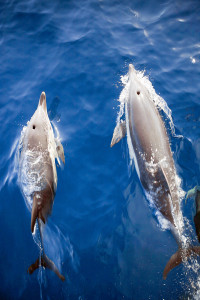 At the end of last year, a study was released revealing that the bottlenose dolphins in the Everglades show signs of mercury poisoning. Florida International University (FIU) scientists have been examining the dolphins, and released the study that stated the dolphins have a high mercury concentration on both their skin and blubber. These dolphins that were examined live around the Everglades National Park, the lower Florida Keys, and Florida Bay. These dolphins have a high mercury concentration them than any other dolphin population in the world. In fact, the level of mercury these scientists found was the highest level ever recorded.
At the end of last year, a study was released revealing that the bottlenose dolphins in the Everglades show signs of mercury poisoning. Florida International University (FIU) scientists have been examining the dolphins, and released the study that stated the dolphins have a high mercury concentration on both their skin and blubber. These dolphins that were examined live around the Everglades National Park, the lower Florida Keys, and Florida Bay. These dolphins have a high mercury concentration them than any other dolphin population in the world. In fact, the level of mercury these scientists found was the highest level ever recorded.
The scientists believe the mercury has come from natural and man-made sources. Mercury is a metallic element, and is extremely toxic. Because of its toxicity, the mercury can affect and harm dolphins’ immune and reproductive systems, which can make them susceptible to catching and contracting illnesses and diseases easier and more often.
FIU has reported that mercury is produced from the mangroves in these areas. This occurs when the mangroves’ leaves fall into the water and come in contact with bacteria; the combination converts into mercury. In this area, pesticides are the culprit for the mercury production.
The Everglades has been known to have high concentrations of mercury, which is alarming to scientists. FIU scientists, along with scientists from the University of Liège in Belgium, the University of Gronigen in the Netherlands and the Tropical Dolphin Research Foundation in the United States, are working to understand the impact of these contaminations and pollutants on marine ecosystems to better know how to implement conversation efforts. These scientists are trying to find the extent of mercury poisoning in the Everglades, and will also study sharks, alligators, and fish to see if they also have been affected.
Where to See Dolphins in the Everglades
The bottlenose dolphins mainly reside in the Everglades’ Florida Bay, which is the wetland’s largest body of water. There is about 450 dolphins that live there. Hopefully with attention and awareness on the mercury issue, these dolphins will continue to thrive and live in the Everglades for years to come. Jump on an airboat ride to get a spectacular view of these brilliant, beautiful creatures.
By taking an airboat right with Captain Mitch’s Airboat Tours, you will have the opportunity to see dolphins and lots of other animals, birds, and marine life. To schedule a tour, click here of call 239-695-3377.






